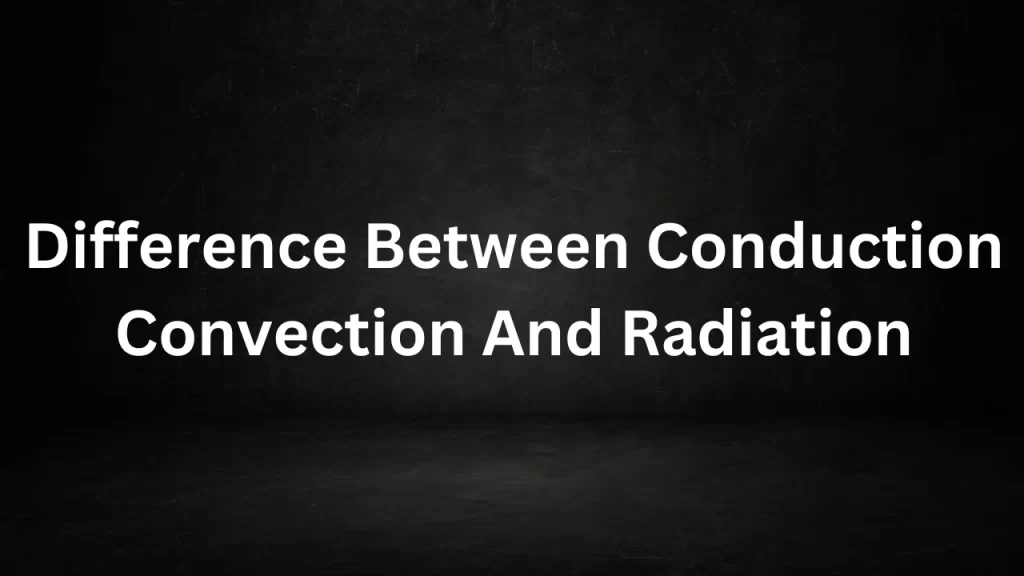Tag: convection vs conduction vs radiation
Difference Between Conduction Convection And Radiation
Difference Between Conduction Convection And Radiation: Heat transfer is a fundamental concept in thermodynamics and plays a crucial role in our everyday lives. There are three primary mechanisms by which heat is transferred:
conduction, convection, and radiation. Each of these processes operates differently and is responsible for heat transfer in various scenarios. In this article, we will delve into the differences between conduction, convection, and radiation to gain a better understanding of these essential principles of heat transfer.
 Difference Between Conduction Convection And Radiation
Difference Between Conduction Convection And Radiation
Conduction
Conduction is the process of heat transfer through direct contact between particles or objects. It occurs in solids, where heat energy is conducted from the hotter region to the colder region through the collisions between adjacent particles. Here are some key characteristics of conduction:
- Direct Contact: Conduction requires direct physical contact between the materials involved. Heat travels through the vibrations and collisions of atoms and molecules in the material.
- Materials: Solids are the primary conductors of heat. Metals, in particular, are excellent conductors due to their closely packed atomic structure.
- Rate of Transfer: The rate of heat transfer by conduction depends on the thermal conductivity of the material, the temperature difference, and the cross-sectional area through which heat flows.
- Examples: Cooking utensils on a hot stove, a metal spoon becoming hot when placed in a hot liquid, or a metal rod heating up when one end is exposed to a flame are all examples of conduction.
Convection
Convection is the process of heat transfer through the movement of fluids (liquids or gases). It occurs when a fluid with different temperatures flows, causing warmer portions to rise and cooler portions to sink. Convection can be natural or forced, and it plays a significant role in various phenomena:
- Fluid Movement: Convection requires the movement of the fluid, either naturally (due to buoyancy forces) or artificially (through fans or pumps).
- Material State: Convection occurs mainly in fluids (liquids or gases) and is less relevant in solids.
- Examples: Boiling water in a kettle, heating a room with a radiator, or the circulation of air in the Earth’s atmosphere are all examples of convection.
Radiation
Radiation is the transfer of heat energy through electromagnetic waves, such as infrared radiation. Unlike conduction and convection, radiation does not require a material medium and can occur through a vacuum. Key characteristics of radiation include:
- No Medium Required: Radiation can occur through a vacuum or through transparent materials. It does not rely on the physical contact of particles.
- Emission and Absorption: All objects emit and absorb radiation to varying degrees. Dark and rough surfaces are better at emitting and absorbing radiation than light and smooth surfaces.
- Speed of Light: Radiation travels at the speed of light, making it the fastest mode of heat transfer.
- Examples: The Sun’s heat reaching the Earth, the warmth felt when standing near a fire, and the use of infrared heaters are examples of radiation.
Conclusion
In summary, conduction, convection, and radiation are distinct mechanisms of heat transfer, each operating under different conditions and principles. Conduction occurs through direct contact in solids, convection involves the movement of fluids, and radiation relies on electromagnetic waves. Understanding these differences is essential for various applications, from cooking to designing efficient heating and cooling systems and even explaining the behavior of the Earth’s climate. These principles of heat transfer are fundamental to our comprehension of how energy is distributed and exchanged in the natural world.
Read More
- Excretory System Class 10
- Sodium Carbonate Molar Mass
- Layers Of The Earth
- Environmental Pollution And Recycle
- Batteries In Series Parallel
- Difference Between Work And Energy
Frequently Asked Questions (FAQs) On Difference Between Conduction Convection And Radiation
1. What is conduction, and how does it work?
Conduction is a method of heat transfer that occurs through direct contact between particles or objects. It involves the transfer of kinetic energy between particles in a solid material through vibrations and collisions.
2. Can conduction occur in fluids (liquids or gases)?
While conduction is primarily associated with solids, it can also occur in fluids, but it is generally less significant in fluids compared to solids.
3. What is convection, and in what materials does it occur?
Convection is the transfer of heat through the movement of fluids (liquids or gases). It occurs primarily in fluids and involves the circulation of warmer fluid rising and cooler fluid sinking.
4. What causes natural convection?
Natural convection is driven by density differences in a fluid due to temperature variations. Warmer fluids become less dense and rise, while cooler fluids become denser and sink.
5. How is forced convection different from natural convection?
Forced convection involves the use of external mechanisms, such as fans or pumps, to actively move the fluid, while natural convection occurs spontaneously due to density differences.